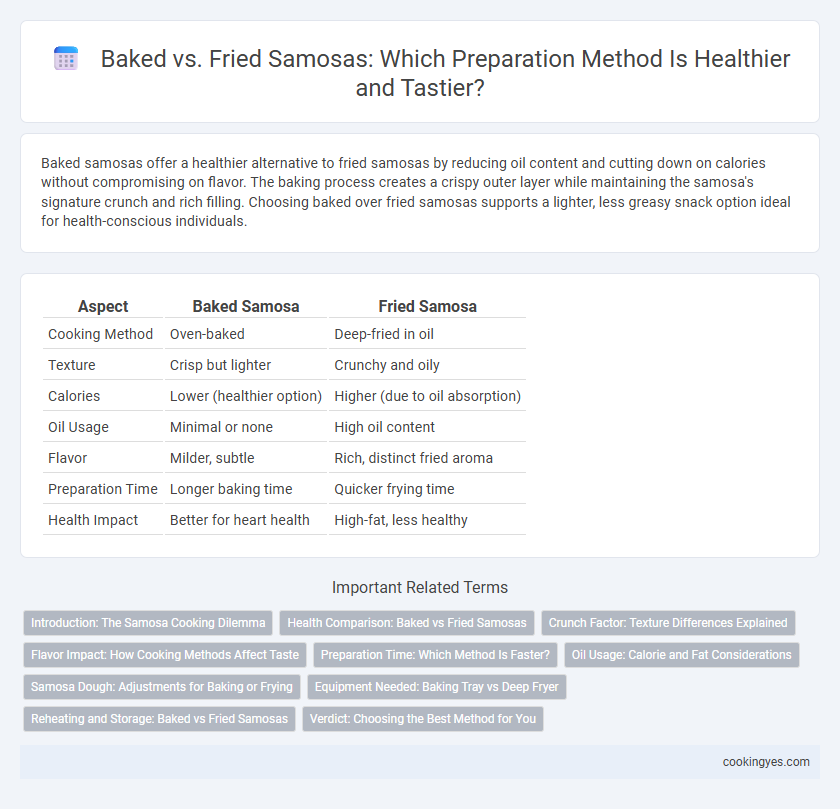Baked samosas offer a healthier alternative to fried samosas by reducing oil content and cutting down on calories without compromising on flavor. The baking process creates a crispy outer layer while maintaining the samosa's signature crunch and rich filling. Choosing baked over fried samosas supports a lighter, less greasy snack option ideal for health-conscious individuals.
Table of Comparison
| Aspect | Baked Samosa | Fried Samosa |
|---|---|---|
| Cooking Method | Oven-baked | Deep-fried in oil |
| Texture | Crisp but lighter | Crunchy and oily |
| Calories | Lower (healthier option) | Higher (due to oil absorption) |
| Oil Usage | Minimal or none | High oil content |
| Flavor | Milder, subtle | Rich, distinct fried aroma |
| Preparation Time | Longer baking time | Quicker frying time |
| Health Impact | Better for heart health | High-fat, less healthy |
Introduction: The Samosa Cooking Dilemma
Baked samosas offer a healthier alternative by significantly reducing oil content while preserving the crispy texture preferred by many. Fried samosas deliver a traditional, rich flavor and crunchy exterior that remains difficult to replicate through baking. Choosing between baked or fried preparation depends on prioritizing health benefits versus authentic taste and texture.
Health Comparison: Baked vs Fried Samosas
Baked samosas typically contain less oil, resulting in lower calorie and fat content compared to fried samosas, making them a healthier option for heart-conscious individuals. The baking process reduces the risk of consuming harmful trans fats that can form during deep frying at high temperatures. Additionally, baked samosas retain more nutrients and reduce the overall glycemic index, contributing to better digestion and metabolic health.
Crunch Factor: Texture Differences Explained
Baked samosas offer a crispy exterior with a lighter crunch, resulting from even heat distribution and less oil absorption. Fried samosas deliver a more intense crunch due to deep frying, which creates a thicker, bubbly crust that seals in moisture. Texture differences between baked and fried samosas affect overall mouthfeel, with fried samosas typically providing a richer, crisper bite compared to the moderately crunchy baked version.
Flavor Impact: How Cooking Methods Affect Taste
Baked samosas offer a lighter, crisp texture with a subtly toasted flavor that enhances the natural taste of the filling without overwhelming it. Fried samosas develop a richer, more intense flavor due to the Maillard reaction, creating a golden, crunchy exterior that intensifies the savory notes. The choice between baking and frying significantly influences the flavor profile, balancing health considerations with taste preferences.
Preparation Time: Which Method Is Faster?
Fried samosas typically require less preparation time due to quicker cooking at high heat, usually taking about 4-6 minutes per batch. Baked samosas need longer, around 20-25 minutes, as they cook evenly in an oven at a moderate temperature. Choosing frying expedites preparation but baking offers a healthier alternative with more even cooking.
Oil Usage: Calorie and Fat Considerations
Baked samosas significantly reduce oil usage compared to traditional frying, resulting in lower calorie and fat content per serving. Fried samosas absorb more oil during cooking, increasing their overall caloric density and saturated fat levels that may impact heart health. Choosing baked samosas offers a healthier alternative by minimizing unhealthy fat intake while maintaining crisp texture.
Samosa Dough: Adjustments for Baking or Frying
Samosa dough requires specific adjustments based on the cooking method to achieve optimal texture and flavor. For baking, incorporating a higher fat content, such as butter or oil, creates a flakier and crispier crust without excess oil absorption. In frying, the dough should have a slightly stiffer consistency to hold the shape and prevent sogginess while ensuring a golden, crunchy exterior.
Equipment Needed: Baking Tray vs Deep Fryer
Baked samosas require a sturdy baking tray that ensures even heat distribution and prevents sticking, often lined with parchment paper for easy cleanup. Fried samosas need a deep fryer or a heavy-bottomed pot filled with sufficient oil to submerge the pastries, maintaining a consistent temperature around 350degF (175degC) for crispy, golden results. The choice of equipment significantly impacts texture, with baking offering a healthier option and deep frying delivering a traditional crunch.
Reheating and Storage: Baked vs Fried Samosas
Baked samosas maintain a crispier texture longer during storage, making them ideal for reheating without losing crunch, while fried samosas tend to become soggy when refrigerated and reheated. Proper storage in an airtight container is essential for both types, but baked samosas reheat evenly in an oven or air fryer, preserving their flavor and structure better. Fried samosas may require additional oiling or reheating techniques to regain crispness, impacting convenience and overall texture quality after storage.
Verdict: Choosing the Best Method for You
Baked samosas offer a healthier alternative with less oil and a crisp texture, while fried samosas deliver a traditional, golden-brown crunch and richer flavor. The best method depends on your dietary preferences and desired taste profile, with baking suited for lower fat intake and frying preferred for authentic, flavorful results. Consider whether health benefits or classic taste quality aligns more closely with your culinary goals.
Baked vs fried for samosa preparation Infographic

 cookingyes.com
cookingyes.com